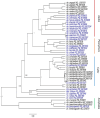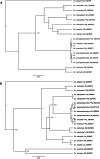Mitogenomes of mosquito species of Harris County in Texas
- PMID: 40593971
- PMCID: PMC12216632
- DOI: 10.1038/s41598-025-04864-x
Mitogenomes of mosquito species of Harris County in Texas
Abstract
Harris County, Texas, remains at continuous risk to mosquito-borne diseases due to its geographic landscape and abundance of medically important mosquito vectors. Targeted mitigation of these mosquitoes requires accurate identification of these mosquitoes taxa. Currently, there is a paucity of genetic information to inform molecular identification and phylogenetic relationships beyond well-studied mosquito species. Here we utilized a genome skimming approach using shallow shot gun sequencing to generate data and assemble the mitochondrial genomes of 37 mosquito species collected in Harris County, Texas. This report includes the complete mitochondrial genome for 25 newly sequenced species spanning 10 genera; the genomes were consistent with reference genomes in the GenBank database having 37 genes (13 protein-coding, 2 rRNA and 22 tRNA), and average AT content of 78.74%. Bayesian and maximum likelihood tree topologies using just the easily aligned 13 concatenated protein coding genes confirmed phylogenetic placement of species for Aedes, Anopheles and Culex genera clustering in single clades as expected. Furthermore, this approach provided more robust phylogenetic placement/identity of study taxa when compared to the use of the traditional cytochrome oxidase I partial gene barcode sequence for molecular identification. This study demonstrates the utility of genome skimming as a cost-effective alternative approach to generate reference sequences for the validation of mosquito identification and taxonomic rectification, knowledge necessary for guiding targeted vector interventions.
© 2025. The Author(s).
Conflict of interest statement
Declarations. Competing interests: The authors declare no competing interests.
Figures





Similar articles
-
Phylogenetic taxonomy of the Zambian Anopheles coustani group using a mitogenomics approach.Malar J. 2025 Jul 1;24(1):203. doi: 10.1186/s12936-025-05461-z. Malar J. 2025. PMID: 40597261 Free PMC article.
-
Phylogenetic taxonomy of the Zambian Anopheles coustani group using a mitogenomics approach.Res Sq [Preprint]. 2025 Apr 7:rs.3.rs-5976492. doi: 10.21203/rs.3.rs-5976492/v1. Res Sq. 2025. Update in: Malar J. 2025 Jul 1;24(1):203. doi: 10.1186/s12936-025-05461-z. PMID: 40297676 Free PMC article. Updated. Preprint.
-
Determination of Species Identity and Genetic Diversity of Aedes aegypti and Other Medically Important Mosquitoes of India Using DNA Barcoding.Am J Trop Med Hyg. 2024 Jul 2;111(2):324-332. doi: 10.4269/ajtmh.23-0471. Print 2024 Aug 7. Am J Trop Med Hyg. 2024. PMID: 38955202 Free PMC article.
-
Indoor residual spraying for preventing malaria in communities using insecticide-treated nets.Cochrane Database Syst Rev. 2022 Jan 17;1(1):CD012688. doi: 10.1002/14651858.CD012688.pub3. Cochrane Database Syst Rev. 2022. PMID: 35038163 Free PMC article.
-
Diagnostic test accuracy and cost-effectiveness of tests for codeletion of chromosomal arms 1p and 19q in people with glioma.Cochrane Database Syst Rev. 2022 Mar 2;3(3):CD013387. doi: 10.1002/14651858.CD013387.pub2. Cochrane Database Syst Rev. 2022. PMID: 35233774 Free PMC article.
References
-
- Simard, F. The Mosquitome: A new frontier for sustainable vector control. in Mosquitopia: The Place of Pests in a Healthy World (eds. Hall, M. & Tamïr, D.) (Routledge, New York, 2022). - PubMed
-
- Vector-borne diseases. https://www.who.int/news-room/fact-sheets/detail/vector-borne-diseases.
MeSH terms
Grants and funding
LinkOut - more resources
Full Text Sources
Medical

